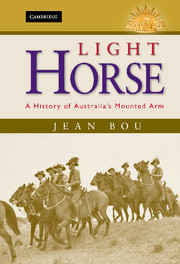Book contents
- Frontmatter
- CONTENTS
- List of maps
- ACKNOWLEDGEMENTS
- AUTHOR'S NOTE
- ABBREVIATIONS
- INTRODUCTION
- CHAPTER 1 ANCESTORS
- CHAPTER 2 TOUGH LESSONS
- CHAPTER 3 THE HUTTON ERA
- CHAPTER 4 UNFULFILLED PROMISE
- CHAPTER 5 THE LIGHT-HORSEMEN 1
- CHAPTER 6 MOUNTED RIFLES
- 7 CAVALRY
- CHAPTER 8 THE LIGHT-HORSEMEN 2
- CHAPTER 9 THE FINAL YEARS
- CONCLUSION
- EPILOGUE
- APPENDIX THE ‘BEERSHEBA CHARGE PHOTO’
- Notes
- BIBLIOGRAPHY
- INDEX
CONCLUSION
Published online by Cambridge University Press: 05 July 2014
- Frontmatter
- CONTENTS
- List of maps
- ACKNOWLEDGEMENTS
- AUTHOR'S NOTE
- ABBREVIATIONS
- INTRODUCTION
- CHAPTER 1 ANCESTORS
- CHAPTER 2 TOUGH LESSONS
- CHAPTER 3 THE HUTTON ERA
- CHAPTER 4 UNFULFILLED PROMISE
- CHAPTER 5 THE LIGHT-HORSEMEN 1
- CHAPTER 6 MOUNTED RIFLES
- 7 CAVALRY
- CHAPTER 8 THE LIGHT-HORSEMEN 2
- CHAPTER 9 THE FINAL YEARS
- CONCLUSION
- EPILOGUE
- APPENDIX THE ‘BEERSHEBA CHARGE PHOTO’
- Notes
- BIBLIOGRAPHY
- INDEX
Summary
The light horse's last years were unfortunate ones. The now perfected internal combustion engine, along with armoured protection and heavy armament, had finally been combined to produce machines that could do almost everything that cavalry had been doing for centuries. Military horsemen continued to exist, but it now became a niche role, generally utilised as a supplement to motorised or mechanised forces, or in those places where terrain made the use of vehicles impossible, or at least impracticable. The light horse, like so many other cavalry forces, was completely overtaken by these events and disappeared. That the interwar period had seen it starved of resources and few efforts made to adjust its doctrine or organisation did little to help.
The eclipse of cavalry had been long coming and, as this book has shown, had been predicted as long ago as the middle of the nineteenth century. That challenge brought on various responses from a whole range of would-be reformers. Most reformers believed that cavalry had to embrace firepower and modify its operational action in order to survive. How firepower should be embraced, and whether that embrace should also see the rejection of the arme blanche, proved to be the crux of the debate. In that debate there were more than a few protagonists, but one of them, George Denison, is particularly noteworthy for anyone with an interest in Australian mounted troops because he won a number of adherents, most notably Edward Hutton, who went on to have a profound influence on Australia's mounted arm.
- Type
- Chapter
- Information
- Light HorseA History of Australia's Mounted Arm, pp. 256 - 261Publisher: Cambridge University PressPrint publication year: 2009

